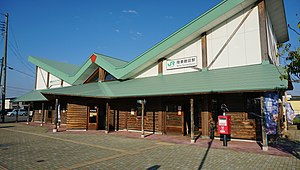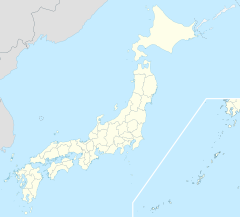Mutsu-Tsuruda Station
Mutsu-Tsuruda Station 陸奥鶴田駅 | |||||||||||||||
|---|---|---|---|---|---|---|---|---|---|---|---|---|---|---|---|
 Mutsu-Tsuruda Station in September 2019 | |||||||||||||||
| General information | |||||||||||||||
| Location | Maeda 38, Tsuruta-cho, Kitatsugaru-gun, Aomori-ken 038-3503 Japan | ||||||||||||||
| Coordinates | 40°45′26.52″N 140°26′06.91″E / 40.7573667°N 140.4352528°E | ||||||||||||||
| Operated by | |||||||||||||||
| Line(s) | ■ Gonō Line | ||||||||||||||
| Distance | 131.7 kilometers from Higashi-Noshiro | ||||||||||||||
| Platforms | 1 side platform | ||||||||||||||
| Other information | |||||||||||||||
| Status | Unstaffed | ||||||||||||||
| Website | www | ||||||||||||||
| History | |||||||||||||||
| Opened | September 25, 1918 | ||||||||||||||
| Passengers | |||||||||||||||
| FY2016 | 195 | ||||||||||||||
| Services | |||||||||||||||
| |||||||||||||||
| |||||||||||||||
Mutsu-Tsuruda Station (陸奥鶴田駅, Mutsu-Tsuruda-eki) is a railway station located in the town of Tsuruta, Aomori Prefecture Japan, operated by the East Japan Railway Company (JR East).
Lines[edit]
Mutsu-Tsuruda Station is served by the Gonō Line, and is 131.7 rail kilometers from the terminus of the line at Higashi-Noshiro.
Station layout[edit]
Mutsu-Tsuruda Station has a single island platform; however, one track is not used, making it effectively a side platform station serving bi-directional traffic. The station building is staffed during normal daytime hours.
Route bus[edit]
- Kōnan Bus
- For Goshogawara Station
History[edit]
Mutsu-Tsuruda Station was opened on September 25, 1918 as a station on the Mutsu Railway. It became a station on the Japan National Railways (JNR) when the Mutsu Railway was nationalized on June 1, 1927. With the privatization of the JNR on April 1, 1987, it came under the operational control of JR East.
Passenger statistics[edit]
In fiscal 2016, the station was used by an average of 195 passengers daily (boarding passengers only).[1]
Surrounding area[edit]
 National Route 339
National Route 339- Tsuruta Town Hall
- Tsuruta Post office
- Tsuruta High School
See also[edit]
References[edit]
- ^ 各駅の乗車人員 (2016年度) [Station passenger figures (Fiscal 2016)] (in Japanese). Japan: East Japan Railway Company. 2017. Retrieved 1 January 2018.
- Endo, Isao (2006). 五能線物語 「奇跡のローカル線」を生んだ最強の現場力 (Gono-sen Monogatari) (in Japanese). PHP研究所. ISBN 4569830099.
- 五能線ガイドブック (Gono-sen Guidebook) (in Japanese). 無明舎出版. 2002. ISBN 4895443078.
External links[edit]
- Official website (in Japanese)

